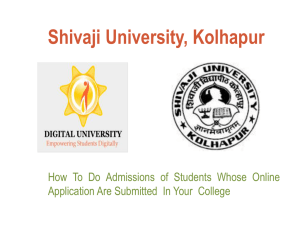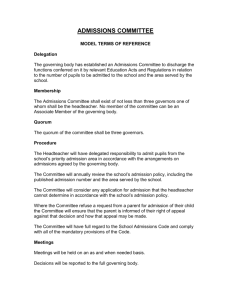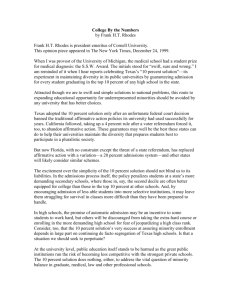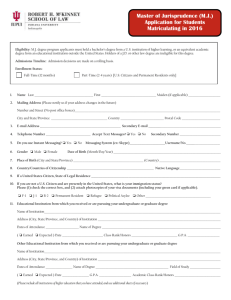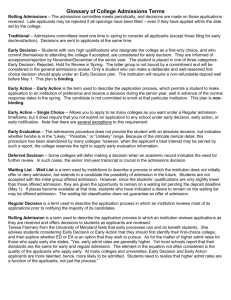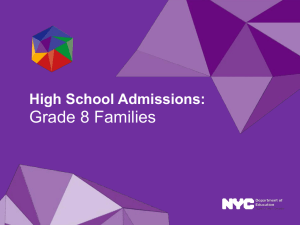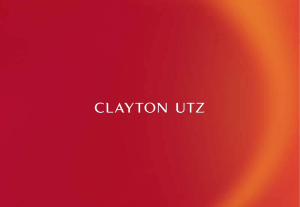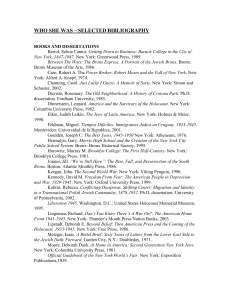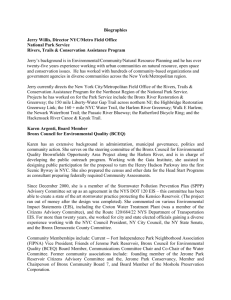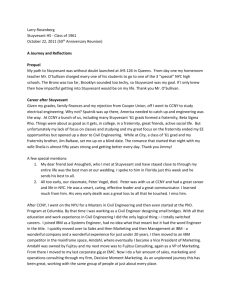Specialized High Schools
advertisement
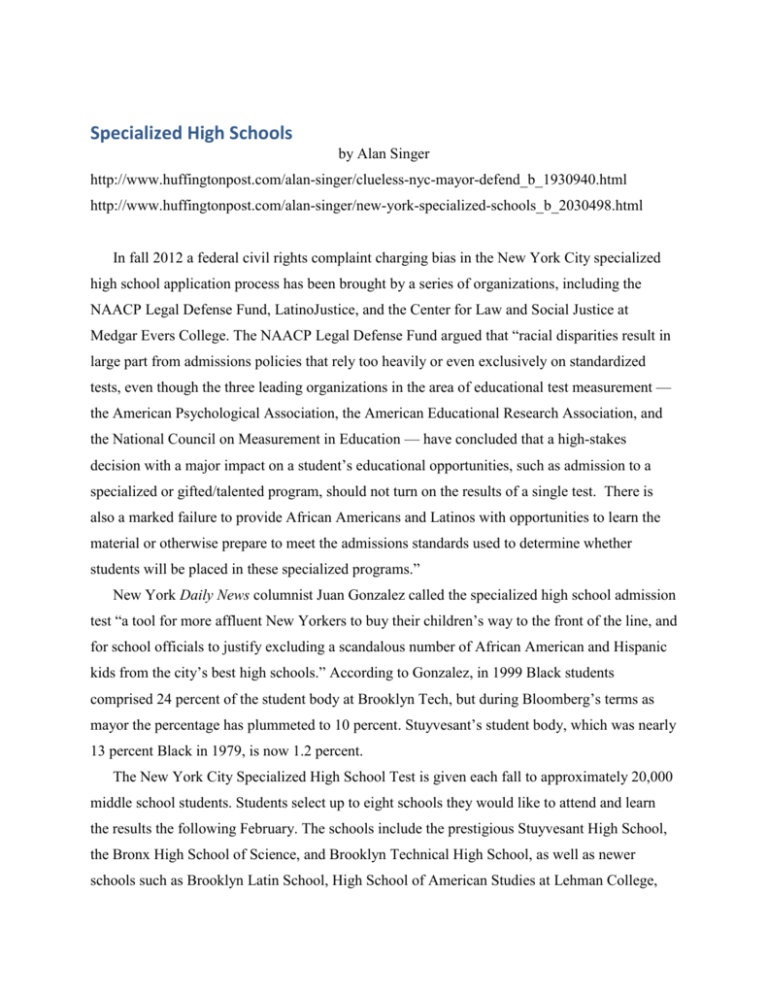
Specialized High Schools by Alan Singer http://www.huffingtonpost.com/alan-singer/clueless-nyc-mayor-defend_b_1930940.html http://www.huffingtonpost.com/alan-singer/new-york-specialized-schools_b_2030498.html In fall 2012 a federal civil rights complaint charging bias in the New York City specialized high school application process has been brought by a series of organizations, including the NAACP Legal Defense Fund, LatinoJustice, and the Center for Law and Social Justice at Medgar Evers College. The NAACP Legal Defense Fund argued that “racial disparities result in large part from admissions policies that rely too heavily or even exclusively on standardized tests, even though the three leading organizations in the area of educational test measurement — the American Psychological Association, the American Educational Research Association, and the National Council on Measurement in Education — have concluded that a high-stakes decision with a major impact on a student’s educational opportunities, such as admission to a specialized or gifted/talented program, should not turn on the results of a single test. There is also a marked failure to provide African Americans and Latinos with opportunities to learn the material or otherwise prepare to meet the admissions standards used to determine whether students will be placed in these specialized programs.” New York Daily News columnist Juan Gonzalez called the specialized high school admission test “a tool for more affluent New Yorkers to buy their children’s way to the front of the line, and for school officials to justify excluding a scandalous number of African American and Hispanic kids from the city’s best high schools.” According to Gonzalez, in 1999 Black students comprised 24 percent of the student body at Brooklyn Tech, but during Bloomberg’s terms as mayor the percentage has plummeted to 10 percent. Stuyvesant’s student body, which was nearly 13 percent Black in 1979, is now 1.2 percent. The New York City Specialized High School Test is given each fall to approximately 20,000 middle school students. Students select up to eight schools they would like to attend and learn the results the following February. The schools include the prestigious Stuyvesant High School, the Bronx High School of Science, and Brooklyn Technical High School, as well as newer schools such as Brooklyn Latin School, High School of American Studies at Lehman College, High School for Math, Science and Engineering at City College, Queens High School for the Sciences at York College, and Staten Island Technical High School. New York City Mayor Michael R. Bloomberg defended the select schools, the admission process, and the admission test, claiming it was “designed for the best and the brightest” and that he saw no need to change the admissions policy or state law. The mayor declared, “I think that Stuyvesant and these other schools are as fair as fair can be. . . . There’s nothing subjective about this. You pass the test, you get the highest score, you get into the school—no matter what your ethnicity, no matter what your economic background is. That’s been the tradition in these schools since they were founded, and it’s going to continue to be.” Apparently the mayor was unaware of the way the admission process for the Specialized High Schools actually works. There is no passing grade. Instead, New York City rations seats in these schools. It admits only the top scorers, and the “passing” score varies from year to year. Students with the highest test scores get their choice of schools, with many qualified students closed out. For example, in 2004, a score of 567 earned a student admission to Stuyvesant High School. The minimum score for Bronx Science was 522, and it was 493 for Brooklyn Tech. However in 2006, a student could be admitted to Stuyvesant with a 558 and Bronx Science with a 510. Because of these fluctuations and the rationing of seats, qualified students capable of doing the work can miss the cutoff and be denied admission. The controversy over admission to New York City’s elite high schools is not new. In May 1971, New York Times education columnist Fred Hechinger reported that efforts were being made to eliminate a “discovery” program that allowed for greater Black and Hispanic enrollment, and school Chancellor Scribner had ordered a study to investigate charges that the entire admission process was discriminatory. To prevent changes, the state legislature passed a law in 1972 to effectively prevent efforts to racially diversify the city’s select high schools, with the single high-stakes test as the only way to gain admission. In 2005, The New York Times reported that the admissions test had not been changed in thirty years and city officials acknowledged they had never conducted studies to gauge the validity of the test. Other select schools around the country, including the Boston Latin School and the Thomas Jefferson High School for Science and Technology in Fairfax, Virginia, evaluate student applications based on test scores, grades, essays, and teacher recommendations. John C. Liu, the comptroller of New York City and a graduate of Bronx Science, denounced the current situation. According to Liu, “The woeful lack of diversity at our Specialized High Schools is troubling and something we have been watching closely. The admissions process—a single, grueling test—is flawed and must be changed. Admissions criteria must be broadened, the test must be analyzed for predictive bias, and the City must do more recruiting for those schools in communities of color.” Part of the problem with the admission process is that it favors students from more affluent families who can pay for expensive test prep classes. Based on online advertising, New York Academics offers one-on-one instruction at fees ranging from $100 to $120 per hour. The Kaplan company offers individual SHSAT Premier Tutoring starting at $2,599 and class at $849. The Princeton Review also has multiple levels of preparation. Its Premier Level costs $6,300, its Master Level costs $3,879, and its low-cost online offering is a bargain at only $1,500. The Kuei Luck Enrichment Center in Fresh Meadows, Queens, targets Chinese-American students and offers tutoring for only $2,200. The problem would be eliminated if there actually was a passing score and every qualified student was assigned to a Specialized High School. I attended the Bronx High School of Science from 1964 through 1967. In those days there was no such thing as test prep, at least not that I am aware of. You either did well on the test and where one of the chosen, or else you were assigned to attend your local high school. I lived in an area of the southwest Bronx near Yankee Stadium that was euphemistically described as a changing neighborhood. That meant working-class Whites, mostly Jews, were moving out of the tenements and projects and Blacks and Puerto Ricans from Harlem and the Lower East Side were moving in. Taft, the local high school, was increasingly seen by White families as dangerous and nonacademic. When one of my friends was sent to Taft, it often was a signal that their family was going to move away. I suspect that specialized high schools and other programs for the “gifted” still play an important role in real estate. As neighborhoods around New York gentrify today, these schools make it possible for White professional families to purchase bargain brownstone in Harlem or Bed-Stuy, Brooklyn, displacing six low-income minority families that had rented in these properties. The White professionals know their children will not have to attend local schools with the other children who have not yet been forced to leave the community. I did not like my experience at the Bronx High School of Science very much. We had too much homework and it interfered with my ability to hang out with my friends from the neighborhood. The teaching was not very special and there was no special “Science” curriculum that I was ever aware of. As far as I know, no one from my graduating class has ever received a Nobel Prize or been awarded a MacArthur grant. When I graduated and went to college I decided a career in science was not for me. Thirty years later, my son attended Stuyvesant High School in Manhattan, and his experience there was not much different from mine at Bronx Science. Again, the teaching was not very special and there was no special “Stuyvesant” curriculum that either of us was aware of. So why are there special schools where the teaching and curriculum are just not that special? The New York Times described the specialized tests and schools “as a vital steppingstone for immigrants.” An article included an interview with a student at the Bronx High School of Science whose family was from Bangladesh, where the student made two very telling points. First, “Most of our parents don’t believe in ‘gifted,’ ” Second, we are in these schools because of “hard work.” The student’s parents drive a taxi and work as a check-out person in a retail store. They see their son’s attendance at Bronx Science as an important step in achieving upward mobility for the family and the American dream.” The article reported that the student spent the summer after sixth grade at a small storefront “cram school” where he memorized mathematical formulas that were on previous tests. In seventh grade, he attended the “cram school” on Saturdays and Sundays, reviewing reading passages that might appear on the test. These classes cost his parents $200 a month for him to participate, but it was seen as an investment in the family’s future. The problem remains that the admission test unfairly favors students whose families can afford to pay for expensive test prep and tutoring. In addition, students who are capable of doing advanced work are denied admission because they fail to make the test cutoff, even though they are capable of doing advanced work. If the specialized high schools are educationally legitimate, and I am not sure they are, there is a solution. First, school districts should identify or develop a specialized high school curriculum so that it is something more than segregating out kids who do well on tests. Second, they need to establish what score on the admission test and what previous school performance qualifies students to study this special curriculum. Instead of rationing seats in a few locations, every student that qualifies should be admitted to the program. Of course in a city as large as New York it will not be possible for all qualified students to take the one-to-two-hour one-way subway trip to Stuyvesant in Manhattan or Science in the Bronx, and there will not be room there for everyone anyway. Instead, once the special curriculum is identified or developed, the city can set up satellite Stuyvesants and Sciences at a number of convenient locations in local high schools and save students the time wasted on the long commutes. I have tremendous respect for the hard work of the young people who attend cram schools in an effort to work their way into the best classes and for parents who make difficult economic sacrifices. But it does not make these children “gifted” and it is not the way to run a school system. For me, at Bronx Science I made some lifelong friends, but I am not sure that would not have happened at any high school that I attended or that it is justification for the select schools. For New York City, I think the main reason for these schools continues to be economics, politics, and real estate values rather than education.
